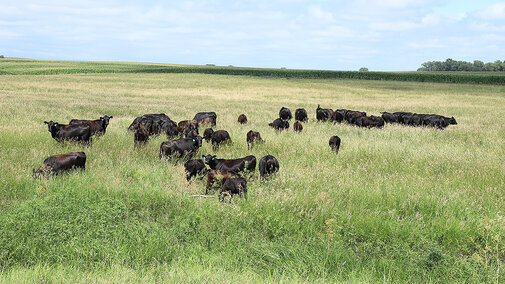Harvesting Summer Annual Grasses
It can be a little tricky to put up good quality hay from summer annual grasses like sorghum-sudan hybrids, pearl millet and forage sorghums. Here are some tips to help make sure these types of hay are of good quality and that hay is dry and will not heat or mold.
Nearly all problems making good summer annual grass or cane hay are caused by their stems. Stems are low in protein and energy, unbearably slow to dry, and the lower stems contain most of the potentially toxic nitrates.
To solve some problems, cut early when plants are only waist high. When cut early, stems are smaller, they’re eaten more readily and the hay contains more protein and energy. Also, there is less plant volume. With smaller stems and fewer of them, the hay will dry quicker. Though you will have less tonnage when cutting early, you are creating more days for regrowth and a good second cutting.
Regardless of when you harvest though, cut it high, leaving eight to 10 inches of stubble. Tall stubble pays off three ways — it helps plants begin regrowth quicker, it holds hay off the ground so air can help dry underneath, and it keeps many nitrates out in the field stubble rather than harvesting them all in your hay.
And finally, always crimp the hay. Even when stems are small, the waxy coating on the stems cause slow drying. But if you break open these stems by crimping, water will be able to escape and evaporate more quickly.
So cut it early, cut it high. Crimp the stems and they will dry.
Hail in Pasture and Hay
Row crops often get priority attention when a hailstorm rolls through, but bad storms can do a number on perennial forages, as well. When hail strikes your pasture or hay field, do you know what to do?
Timing of hail is probably the most important factor when assessing hail impacts on forage crops. Because our perennial forage crops are resilient, they do put up with regular grazing or haying — after all, the real danger of a hail event is lost yield.
In pastures where standing forage may now be lying on the ground, it’s a good idea to move animals from the affected pasture to allow plants to recover. If regrowth does occur, graze appropriately so overuse doesn’t occur. When dry conditions and hail intersect, regrowth may not happen and returning animals to the pasture may not be an option until moisture returns.
In alfalfa fields, the amount of damage inflicted and timing are key. The University of Wisconsin recommends management by assessing damage based on plant stages of development. Fields with over two weeks to go before harvest can often be left alone and harvested normally, with some yield loss expected. If damage of terminal buds is over 50%, management should instead focus on harvesting regrowth appropriately.
Stands with less than two weeks to go until planned harvest can be harvested normally, with expected yield loss. For those with severe lodging, wait 3-4 days for plants to right themselves. Disk mowers are better at picking up a lodged crop than sickle bars, but for both, tilt the bar or disc forward to increase forage pickup.
If stand damage is severe enough that expected yield does not justify harvesting, management should focus on the harvest of regrowth.
Hailstorms are an unavoidable part of living on the plains. When a storm impacts your forage production, assessing damage and adjusting management appropriately can help make the best of an unfortunate situation.
Heat Effects on Alfalfa
As we move into the “dog days of summer” — also known as the extreme heat period — keep in mind that forage plants also must adjust to these temperatures.
When it gets hot, alfalfa plants grow more slowly and moisture stress becomes common, even in moist soil. Production of high-quality hay is nearly impossible due to the high temperatures, especially when the heat does not subside at night. High nighttime temperatures cause rapid respiration rates in alfalfa, burning off valuable nutrients that plants accumulated during the day. This often produces alfalfa hay with fine stems that contain high protein, but they also have high fiber and low relative feed value. So, if your hay tests low, blame the heat.
Another problem with heat is how fast alfalfa plants mature. When it is hot, alfalfa may begin to bloom in less than four weeks. If you use blooming as a signal to harvest, this early bloom can be misleading. During hot weather, alfalfa plants need more time — not less — to rebuild nutrient reserves in their roots because they burn off nutrients instead of moving them to the roots when it is hot. So, watch the calendar as well as your plants to determine when to cut your alfalfa fields.
You might also adjust the time of day when you cut hay. Some research has shown that cutting in late afternoon produces higher quality hay than cutting in the morning. However, on good drying days, it may still be wiser to cut in the morning. When hay in the windrow stays above 50% moisture, plant cells continue to respire, burning away nutrients. Hay cut late in the day respires all night long, losing yield and quality. On good drying days, plant cells can dry enough to be stabilized before nightfall, reducing respiration losses.
Getting high quality hay is challenging. Both you and the weather must cooperate and even then, there are no guarantees.

